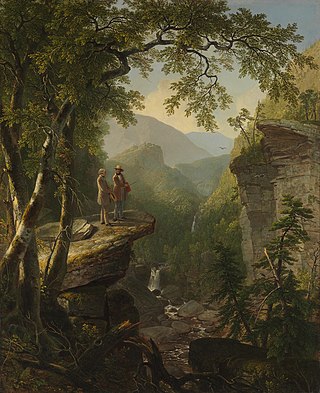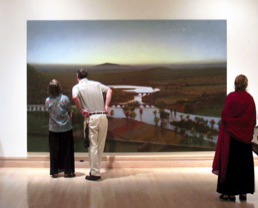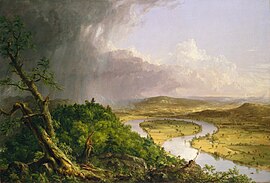Background
Between 1833 and 1836, Thomas Cole, American painter and putative founder of the Hudson River School [2] had been hard at work on his series of paintings The Course of Empire . The work was commissioned by New York patron Luman Reed, who had met Cole in 1832, and the two held a friendship largely based on Reed's generosity in buying Cole's paintings. [3] Reed requested The Course of Empire to comprise no less than five paintings of a historic composition. Cole himself was excited by such a project, but doubt began to set in by the end of 1835. The work was slow and laborious, and Cole found great difficulty in painting the figures. Reed had begun to notice Cole was becoming lonely and depressed, and suggested that he suspend work on The Course of Empire and paint something that was more in his element for the April 1836 opening of the National Academy of Design's annual exhibition. [4] Cole, in replying to Reed in a letter, stated that he felt obliged to finish the series as Reed had been so generous in his support, and instead suggested that he simply complete the last painting in the series and display that at the exhibition. Reed however, did not really like the idea, as he thought it might spoil the unveiling of the series as a whole. He suggested instead that he paint a picture much like the already completed second painting in the series, The Pastoral State. This depicted a peaceful setting which Reed thought "no man ever produced a more pleasing landscape in a more pleasing season." Responding in a letter in March 1836, Cole agreed to take Reed's advice and paint a picture for the exhibition, writing: [5]
Fancy pictures seldom sell & they generally take more time than views so I have determined to paint one of the latter. I have already commenced a view from Mt. Holyoke —it is about the finest scene I have in my sketchbook & is well known—it will be novel and I think effective—I could not find a subject very similar to your second picture & time would not allow me to invent one.
Cole also comments that he used a larger canvas, as he was not able to ready a smaller frame in time for the exhibition, and moreover felt compelled to make a statement with the one painting he was to present. [5]

Mount Holyoke, a traprock mountain, elevation 935 feet (285 m), is the westernmost peak of the Holyoke Range and part of the 100-mile (160 km) Metacomet Ridge. The mountain is located in the Connecticut River Valley of western Massachusetts, and is the namesake of nearby Mount Holyoke College. The mountain is located in the towns of Hadley and South Hadley, Massachusetts. It is known for its historic summit house, auto road, scenic vistas, and biodiversity. The mountain is crossed by the 110-mile (180 km) Metacomet-Monadnock Trail and numerous shorter trails. Mount Holyoke is the home of J.A. Skinner State Park which is accessible from Route 47 in Hadley, Massachusetts.

Frederic Edwin Church was an American landscape painter born in Hartford, Connecticut. He was a central figure in the Hudson River School of American landscape painters, best known for painting large landscapes, often depicting mountains, waterfalls, and sunsets. Church's paintings put an emphasis on realistic detail, dramatic light, and panoramic views. He debuted some of his major works in single-painting exhibitions to a paying and often enthralled audience in New York City. In his prime, he was one of the most famous painters in the United States.
Events from the year 1836 in art.

The Hudson River School was a mid-19th-century American art movement embodied by a group of landscape painters whose aesthetic vision was influenced by Romanticism. Early on, the paintings typically depicted the Hudson River Valley and the surrounding area, including the Catskill, Adirondack, and White Mountains.

Thomas Cole was an English-born American artist and the founder of the Hudson River School art movement. Cole is widely regarded as the first significant American landscape painter. He was known for his romantic landscape and history paintings. Influenced by European painters, but with a strong American sensibility, he was prolific throughout his career and worked primarily with oil on canvas. His paintings are typically allegoric and often depict small figures or structures set against moody and evocative natural landscapes. They are usually escapist, framing the New World as a natural eden contrasting with the smog-filled cityscapes of Industrial Revolution-era Britain, in which he grew up. His works, often seen as conservative, criticize the contemporary trends of industrialism, urbanism, and westward expansion.

Asher Brown Durand was an American painter of the Hudson River School.

John Frederick Kensett was an American landscape painter and engraver born in Cheshire, Connecticut. He was a member of the second generation of the Hudson River School of artists. Kensett's signature works are landscape paintings of New England and New York State, whose clear light and serene surfaces celebrate transcendental qualities of nature, and are associated with Luminism. Kensett's early work owed much to the influence of Thomas Cole, but was from the outset distinguished by a preference for cooler colors and an interest in less dramatic topography, favoring restraint in both palette and composition. The work of Kensett's maturity features tranquil scenery depicted with a spare geometry, culminating in series of paintings in which coastal promontories are balanced against glass-smooth water. He was a founder of the Metropolitan Museum of Art.

Martin Johnson Heade was an American painter known for his salt marsh landscapes, seascapes, and depictions of tropical birds, as well as lotus blossoms and other still lifes. His painting style and subject matter, while derived from the romanticism of the time, are regarded by art historians as a significant departure from those of his peers.

Thomas Doughty was an American artist associated with the Hudson River School.

Samuel Colman was an American painter, interior designer, and writer, probably best remembered for his paintings of the Hudson River.

Sanford Robinson Gifford was an American landscape painter and a leading member of the second generation of Hudson River School artists. A highly-regarded practitioner of Luminism, his work was noted for its emphasis on light and soft atmospheric effects.

Luminism is an American landscape painting style of the 1850s to 1870s, characterized by effects of light in landscape, through the use of aerial perspective and the concealment of visible brushstrokes. Luminist landscapes emphasize tranquility, and often depict calm, reflective water and a soft, hazy sky. Artists who were most central to the development of the luminist style include Fitz Hugh Lane, Martin Johnson Heade, Sanford Gifford, and John F. Kensett. Painters with a less clear affiliation include Frederic Edwin Church, Jasper Cropsey, Albert Bierstadt, Worthington Whittredge, Raymond Dabb Yelland, Alfred Thompson Bricher, James Augustus Suydam, and David Johnson. Some precursor artists are George Harvey and Robert Salmon. Joseph Rusling Meeker also worked in the style.

Kindred Spirits (1849) is a painting by Asher Brown Durand, a member of the Hudson River School of painters. It depicts the painter Thomas Cole, who had died in 1848, and his friend, the poet William Cullen Bryant, in the Catskill Mountains. The landscape painting, which combines geographical features in Kaaterskill Clove and a minuscule depiction of Kaaterskill Falls, is not a literal depiction of American geography. Rather, it is an idealized memory of Cole's discovery of the region more than twenty years prior, his friendship with Bryant, and his ideas about American nature.

White Mountain art is the body of work created during the 19th century by over four hundred artists who painted landscape scenes of the White Mountains of New Hampshire in order to promote the region and, consequently, sell their works of art.

Stephen Hannock is an American painter known for his atmospheric landscapes––compositions of flooded rivers, nocturnes and large vistas––which often incorporate text inscriptions that relate to family, friends or events of daily life. The artist is known for creating a unique luminosity using a signature technique that involves building up layers of paint on the canvas, sandpaper-polishing it, applying new layers of paint and polishing again. Some of his work is thought to be inspired by the Hudson River School.

Mount Nonotuck, 827 feet (252 m), is the northernmost peak of the Mount Tom Range of traprock mountains located in the Connecticut River Valley of Massachusetts and part of the larger Metacomet Ridge which stretches from Long Island Sound to nearly the Vermont border. Rugged and considered scenic, the peak rises steeply from the river valley 700 feet (210 m) below. It is located within the town of Holyoke.

The Oxbow, also known as the Ox-Bow, is an extension of the Connecticut River, located in Northampton, Massachusetts. It is well-known for its appearance in the 1836 painting The Oxbow by Thomas Cole.

The Titan's Goblet is an oil painting by the English-born American landscape artist Thomas Cole. Painted in 1833, it is perhaps the most enigmatic of Cole's allegorical or imaginary landscape scenes. It is a work that "defies full explanation", according to the Metropolitan Museum of Art. The Titan's Goblet has been called a "picture within a picture" and a "landscape within a landscape": the goblet stands on conventional terrain, but its inhabitants live along its rim in a world all their own. Vegetation covers the entire brim, broken only by two tiny buildings, a Greek temple and an Italian palace. The vast waters are dotted with sailing vessels. Where the water spills upon the ground below, grass and a more rudimentary civilization spring up.

Niagara is an oil painting produced in 1857 by the American artist Frederic Edwin Church. Niagara was his most important work to date, and confirmed his reputation as the premier American landscape painter of the time. In his history of Niagara Falls, Pierre Berton writes, "Of the hundreds of paintings made of Niagara, before Church and after him, this is by common consent the greatest."

















